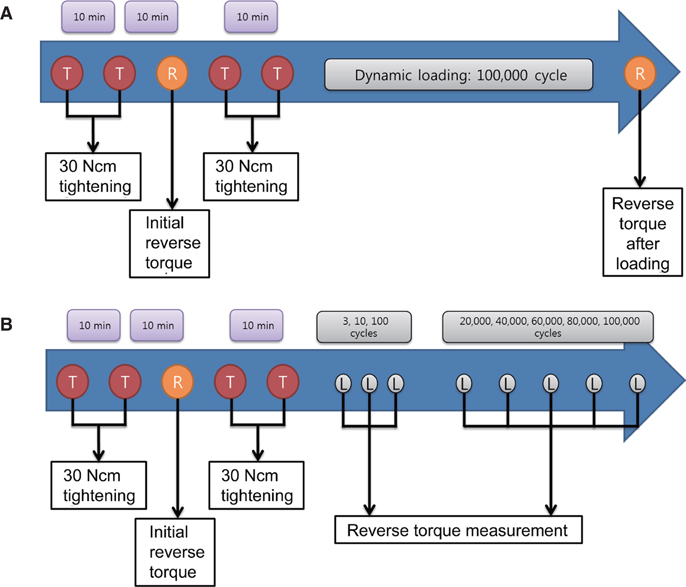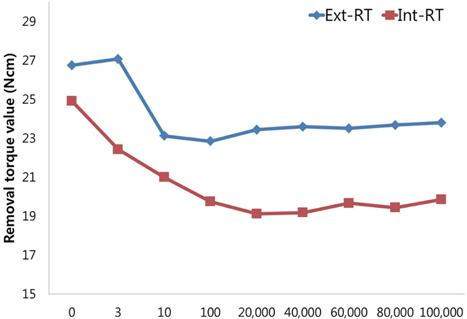J Adv Prosthodont.
2015 Aug;7(4):288-293. 10.4047/jap.2015.7.4.288.
Effect of cyclic loading and retightening on reverse torque value in external and internal implants
- Affiliations
-
- 1Department of Prosthodontics and Research Institute of Oral Science, College of Dentistry, Gangneung-Wonju National University, Gangneung, Republic of Korea. lila@gwnu.ac.kr
- KMID: 2118264
- DOI: http://doi.org/10.4047/jap.2015.7.4.288
Abstract
- PURPOSE
The aim of this study was to evaluate the effect of cyclic loading and screw retightening on reverse torque value (RTV) in external and internal type implants.
MATERIALS AND METHODS
Cement-retained abutments were connected with 30 Ncm torque to external and internal type implants. Experimental groups were classified according to implant connection type and retightening/loading protocol. In groups with no retightening, RTV was evaluated after cyclic loading for 100,000 cycles. In groups with retightening, RTV was measured after 3, 10, 100 cycles as well as every 20,000 cycles until 100,000 cycles of loading.
RESULTS
Every group showed decreased RTV after cyclic loading. Before and after cyclic loading, external type implants had significantly higher RTVs than internal type implants. In external type implants, retightening did not affect the decrease in RTV. In contrast, retightening 5 times and retightening after 10 cycles of dynamic loading was effective for maintaining RTV in internal type implants.
CONCLUSION
Retightening of screws is more effective in internal type implants than external type implants. Retightening of screws is recommended in the early stage of functional loading.
MeSH Terms
Figure
Cited by 2 articles
-
Stability of the prosthetic screws of three types of craniofacial prostheses retention systems
Antonio Gabriel Lanata-Flores, Eder Alberto Sigua-Rodriguez, Douglas Rangel Goulart, Veber Luiz Bomfim-Azevedo, Sergio Olate, José Ricardo de Albergaria-Barbosa
J Korean Assoc Oral Maxillofac Surg. 2016;42(6):352-357. doi: 10.5125/jkaoms.2016.42.6.352.Comparative study of abutment screw loosening with or without adhesive material
Mahnaz Arshad, Gholamreza Shirani, Sina Refoua, Mohammadreza Rahimi Yeganeh
J Adv Prosthodont. 2017;9(2):99-103. doi: 10.4047/jap.2017.9.2.99.
Reference
-
1. Binon PP. Implants and components: entering the new millennium. Int J Oral Maxillofac Implants. 2000; 15:76–94.2. Jung RE, Zembic A, Pjetursson BE, Zwahlen M, Thoma DS. Systematic review of the survival rate and the incidence of biological, technical, and aesthetic complications of single crowns on implants reported in longitudinal studies with a mean follow-up of 5 years. Clin Oral Implants Res. 2012; 23:2–21.3. Pjetursson BE, Thoma D, Jung R, Zwahlen M, Zembic A. A systematic review of the survival and complication rates of implant-supported fixed dental prostheses (FDPs) after a mean observation period of at least 5 years. Clin Oral Implants Res. 2012; 23:22–38.4. Jemt T, Laney WR, Harris D, Henry PJ, Krogh PH Jr, Polizzi G, Zarb GA, Herrmann I. Osseointegrated implants for single tooth replacement: a 1-year report from a multicenter prospective study. Int J Oral Maxillofac Implants. 1991; 6:29–36.5. Henry PJ, Laney WR, Jemt T, Harris D, Krogh PH, Polizzi G, Zarb GA, Herrmann I. Osseointegrated implants for single-tooth replacement: a prospective 5-year multicenter study. Int J Oral Maxillofac Implants. 1996; 11:450–455.6. Khraisat A, Abu-Hammad O, Dar-Odeh N, Al-Kayed AM. Abutment screw loosening and bending resistance of external hexagon implant system after lateral cyclic loading. Clin Implant Dent Relat Res. 2004; 6:157–164.7. Maeda Y, Satoh T, Sogo M. In vitro differences of stress concentrations for internal and external hex implant-abutment connections: a short communication. J Oral Rehabil. 2006; 33:75–78.8. Tsuge T, Hagiwara Y. Influence of lateral-oblique cyclic loading on abutment screw loosening of internal and external hexagon implants. Dent Mater J. 2009; 28:373–381.9. Theoharidou A, Petridis HP, Tzannas K, Garefis P. Abutment screw loosening in single-implant restorations: a systematic review. Int J Oral Maxillofac Implants. 2008; 23:681–690.10. Bickford JH. An introduction to the design and behavior of bolted joints. 3rd ed. New York: Marcel Dekker Inc;1995.11. Siamos G, Winkler S, Boberick KG. Relationship between implant preload and screw loosening on implant-supported prostheses. J Oral Implantol. 2002; 28:67–73.12. Guzaitis KL, Knoernschild KL, Viana MA. Effect of repeated screw joint closing and opening cycles on implant prosthetic screw reverse torque and implant and screw thread morphology. J Prosthet Dent. 2011; 106:159–169.13. Tzenakis GK, Nagy WW, Fournelle RA, Dhuru VB. The effect of repeated torque and salivary contamination on the preload of slotted gold implant prosthetic screws. J Prosthet Dent. 2002; 88:183–191.14. Weiss EI, Kozak D, Gross MD. Effect of repeated closures on opening torque values in seven abutment-implant systems. J Prosthet Dent. 2000; 84:194–199.15. Ricciardi Coppedê A, de Mattos Mda G, Rodrigues RC, Ribeiro RF. Effect of repeated torque/mechanical loading cycles on two different abutment types in implants with internal tapered connections: an in vitro study. Clin Oral Implants Res. 2009; 20:624–632.16. Andersson B, Odman P, Lindvall AM, Lithner B. Single-tooth restorations supported by osseointegrated implants: results and experiences from a prospective study after 2 to 3 years. Int J Oral Maxillofac Implants. 1995; 10:702–711.17. Artzi Z, Dreiangel A. A screw lock for single-tooth implant superstructures. J Am Dent Assoc. 1999; 130:677–682.18. Schwarz MS. Mechanical complications of dental implants. Clin Oral Implants Res. 2000; 11:156–158.19. Cavazos E, Bell FA. Preventing loosening of implant abutment screws. J Prosthet Dent. 1996; 75:566–569.20. Park JK, Choi JU, Jeon YC, Choi KS, Jeong CM. Effects of abutment screw coating on implant preload. J Prosthodont. 2010; 19:458–464.21. McGlumphy EA, Mendel DA, Holloway JA. Implant screw mechanics. Dent Clin North Am. 1998; 42:71–89.22. Haack JE, Sakaguchi RL, Sun T, Coffey JP. Elongation and preload stress in dental implant abutment screws. Int J Oral Maxillofac Implants. 1995; 10:529–536.23. Kim JM, Han JS, Lee SH, Yang JH, Lee JB, Kim YS. A study of screw loosening after dynamic continous fatigue test of several abutment screw. J Korean Acad Prosthodont. 2003; 41:519–531.24. Lee JH, Kim DG, Park CJ, Cho LR. Axial displacements in external and internal implant-abutment connection. Clin Oral Implants Res. 2014; 25:e83–e89.25. Kim KS, Lim YJ, Kim MJ, Kwon HB, Yang JH, Lee JB, Yim SH. Variation in the total lengths of abutment/implant assemblies generated with a function of applied tightening torque in external and internal implant-abutment connection. Clin Oral Implants Res. 2011; 22:834–839.26. Cardoso M, Torres MF, Lourenço EJ, de Moraes Telles D, Rodrigues RC, Ribeiro RF. Torque removal evaluation of prosthetic screws after tightening and loosening cycles: an in vitro study. Clin Oral Implants Res. 2012; 23:475–480.27. Delben JA, Gomes EA, Barão VA, Assunção WG. Evaluation of the effect of retightening and mechanical cycling on preload maintenance of retention screws. Int J Oral Maxillofac Implants. 2011; 26:251–256.28. Binon PP, McHugh MJ. The effect of eliminating implant/abutment rotational misfit on screw joint stability. Int J Prosthodont. 1996; 9:511–519.
- Full Text Links
- Actions
-
Cited
- CITED
-
- Close
- Share
- Similar articles
-
- The influence of abutment screw tightening timing and DLC coating of conical connection implant system
- The assessment of abutment screw stability between the external and internal hexagonal joint under cyclic loading
- Effect of abutment screw length and cyclic loading on removal torque in external and internal hex implants
- Screw loosening and changes in removal torque relative to abutment screw length in a dental implant with external abutment connection after oblique cyclic loading
- The effect of internal implant-abutment connection and diameter on screw loosening





